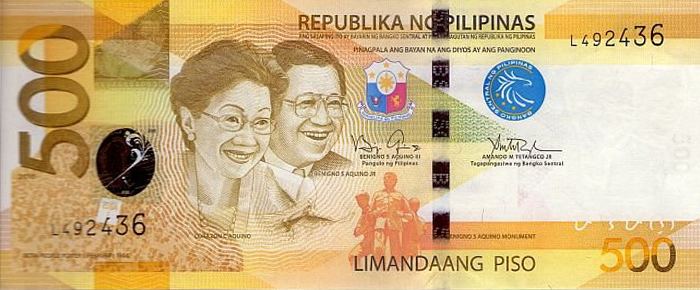The Philippine five hundred-peso note (Filipino: Limandaang Piso) (₱500) is a denomination of Philippine currency. Senator Benigno Aquino, Jr. and his wife, President Corazon Aquino are currently featured on the front side of the bill, while the Puerto Princesa Subterranean River National Park and the blue-naped parrot are featured on the reverse side.
1918: Philippine Islands issued treasury certificate. Features a portrait of Miguel López de Legazpi.
1936: Philippine Commonwealth issued treasury certificate. Features a portrait of Miguel López de Legazpi.
1944: Philippine Commonwealth issued treasury certificate. Features a portrait of Miguel López de Legazpi. This series were later overprinted with the word "VICTORY" after the liberation of the Philippines under Japanese rule in 1944.
1944: Japanese government issued series. Due to hyperinflation caused by the ongoing World War II, the Japanese were forced to issue higher denominations of their fiat peso. The banknotes ceased to be legal tender after the liberation.
1953: English series. Features the portrait of Manuel Roxas, the first president of the independent Republic of the Philippines. The reverse features the Old Central Bank main office. Roxas and the Central Bank building were later featured on the one hundred peso bill upon the introduction of the Pilipino series bills.
1959: The 200 and 500 peso notes were withdrawn from circulation on December 31, 1959, pursuant to Philippine Republic Act No. 1516.
1987: New Design series, The five hundred peso denomination was not included in the Pilipino and Ang Bagong Lipunan series. The denomination however was reintroduced on August 21, 1987, as part of the New Design series notes. The bill now features the portrait of Benigno Aquino, Jr., a former senator and an opposition leader when Ferdinand Marcos was president. The bill is now predominantly yellow in color. The obverse also features two popular quotes from Aquino: "Faith in our people and faith in God", and "The Filipino is worth dying for", under which is signed his nickname, "Ninoy". There is also the signature of Aquino, a typewriter with his initials ("B.S.A.J."), and a dove of peace. The reverse features a collage of various images in relation to Aquino, showing him, inter alia, as a journalist for the Manila Times in front of an article about "1st Cav", a senator (the pioneer of the Study Now, Pay Later education program), the mayor of his hometown of Concepcion, the governor of Tarlac, and as the main driving force behind the People Power Revolution of 1986, some three years after his death in 1983. This is the only bill where the name is written in script.
1993: After the creation of the "Bangko Sentral ng Pilipinas", its new logo was incorporated on all the New Design series bills.
1998: The year of printing was added at the bottom of the denomination value located at the upper left corner of the obverse. The names of the signatories on the bills were later added starting with banknotes featuring the signature of President Joseph Estrada.
2001: Additional security features were added: the security thread on the right side and the gold fluorescent printing on the left side across the portrait.
2010: New Generation series. The portrait of Benigno Aquino, Jr. was redesigned and a portrait of his wife, former president Corazon Aquino, was added, a scene from the EDSA Revolution was added on the lower left of the obverse and the Ninoy Aquino Monument was added in the lower middle. The reverse now features the Puerto Princesa Subterranean River National Park and the blue-naped parrot.
Originally, this banknote was to feature Ferdinand Marcos with the Batasang Pambansa Complex depicted on the reverse. Before the denomination was distributed, Marcos was ousted in the 1986 People Power Revolution. President Corazon Aquino ordered the destruction of all of these banknotes before their release. A concept design of the bill is currently displayed at the BSP Money Museum.
In 2012, a copy of the Marcos ₱500 banknote was discovered in the collection of Wilson Yuloque, which was posted in the blog of Philippine banknote collector Christopher N.C. Gibbs.
The 500 peso bill has sometimes been overprinted to commemorate certain events, including:
60 years of Central Banking Commemorative Banknote - On July 9, 2009, the Bangko Sentral ng Pilipinas introduced 12 million banknotes (2 million banknotes for each denomination) with an overprint commemorating 60 years of central banking. The overprint appears on the watermark area on all six circulating denominations.
45th Annual Meeting of the Asian Development Bank (May 2–5, 2012) Commemorative Banknote - A total of 10 million banknotes with the commemorative overprint were released by the Bangko Sentral ng Pilipinas to the general public to commemorate the Asian Development Bank's recent meetings.

